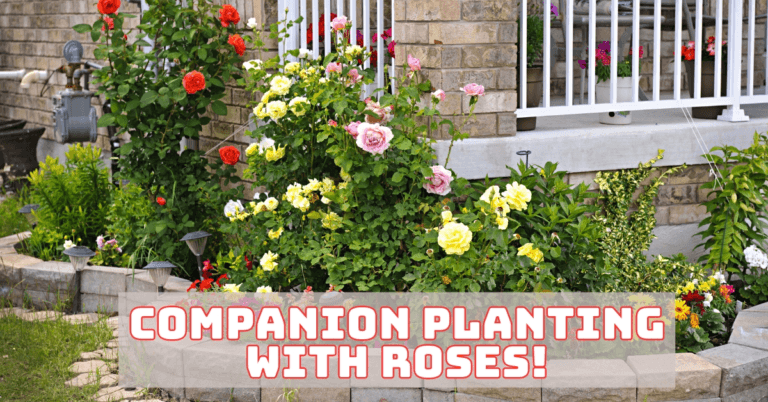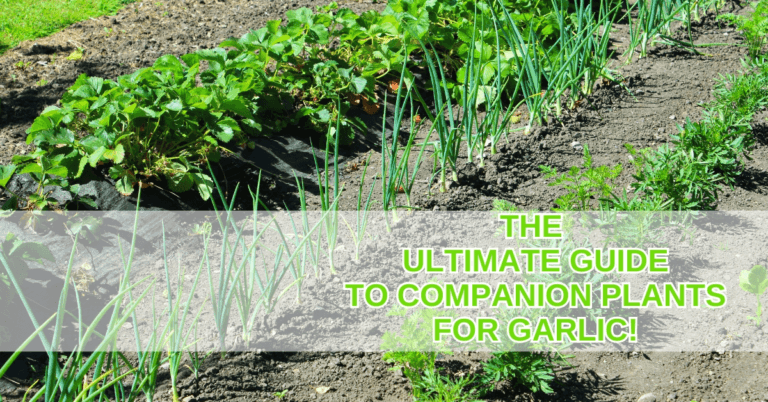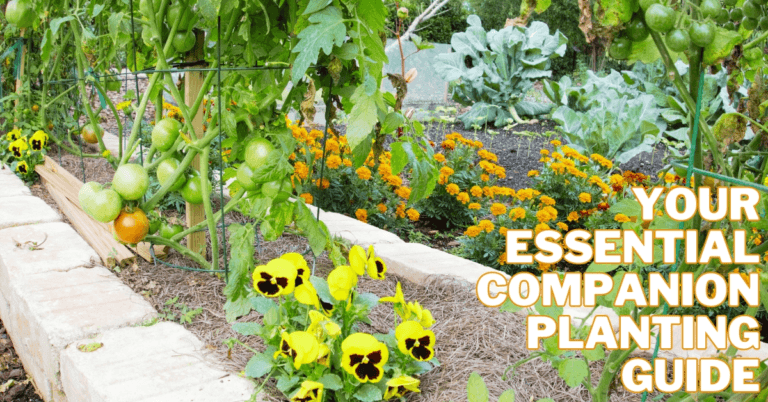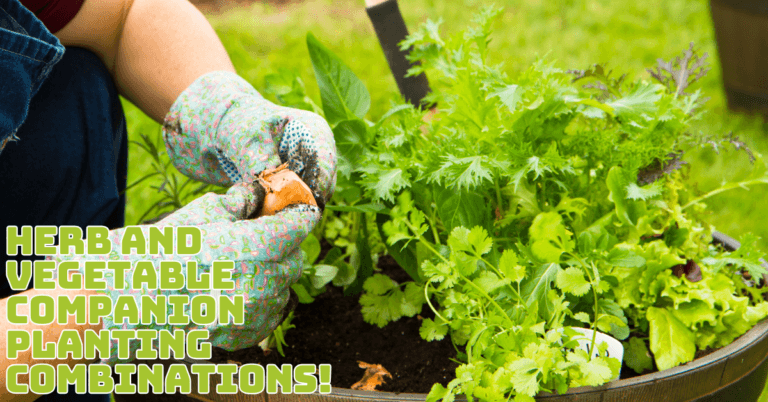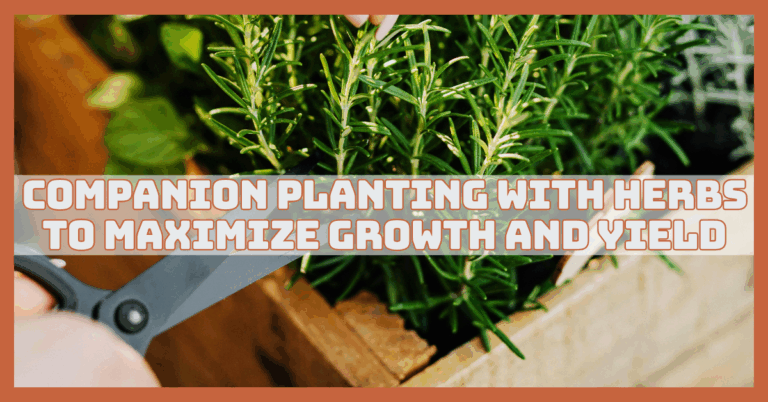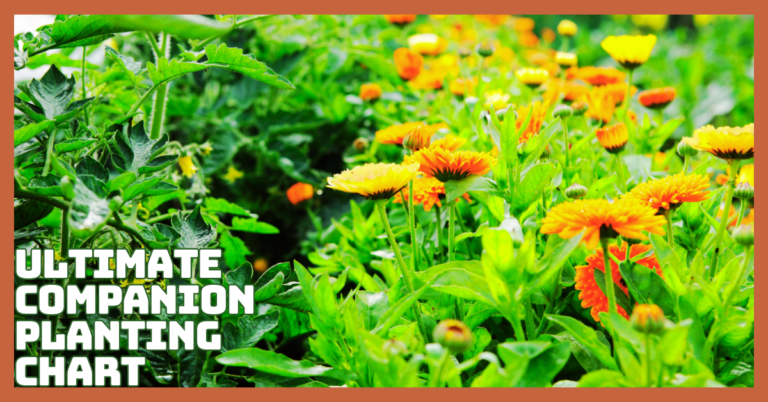Best Herbs To Grow Together For Flavour & Harmony
Herb gardening is a delightful and rewarding pursuit for both beginners and seasoned gardeners. Herbs add fragrance, beauty, and flavour to your garden, provide numerous health benefits, and enhance culinary creations. One of the most effective ways to grow herbs is by planting them together using the companion planting technique.
This comprehensive guide will cover the best herbs to grow together, why some herbs make great companions, and the basics.
Benefits Of Companion Planting
A gardening practice known as companion planting involves growing specific plants together to enhance their productivity, growth, and overall health. Some of the main advantages are as follows:
1. Pest Control
Companion planting helps reduce pests by using plants that naturally repel them. For example, marigolds deter aphids, and basil repels mosquitoes and flies.
This minimizes the need for chemical pesticides, encouraging a balanced, eco-friendly garden where beneficial insects thrive, and destructive pests are effectively controlled.
2. Improved Growth
Certain plants benefit each other when grown together. Tall plants, such as corn, can provide support or shade, while legumes enrich the soil with nitrogen.
This mutual support promotes stronger, healthier growth, increases yields, and creates an optimal growing environment that encourages plants to thrive without relying heavily on fertilizers.
3. Increased Pollination
Companion planting attracts pollinators, such as bees, butterflies, and hoverflies. These beneficial insects help fertilize flowers, increasing fruit and vegetable production.
With more pollinators visiting the garden, plants receive better cross-pollination, leading to improved crop quality and quantity. It also supports biodiversity and encourages a sustainable garden ecosystem.
4. Soil Fertility Enhancement
Certain plants, such as legumes, naturally increase soil fertility by fixing nitrogen. This benefits surrounding crops by providing essential nutrients and reducing their dependency on synthetic fertilizers.
Over time, soil health improves, creating a self-sustaining environment that supports plant growth and promotes long-term productivity for diverse garden beds.
5. Space Maximization
By pairing compatible plants, gardeners can maximize the use of available space. For example, climbing beans can grow up corn stalks, while low-growing herbs cover the soil.
This vertical and horizontal layering increases productivity, reduces bare soil, and creates efficient, high-yield garden layouts ideal for small or intensive garden spaces.
6. Flavour Enhancement
Some plant combinations improve flavour. A classic example is basil grown alongside tomatoes; basil is said to enhance the flavour of tomatoes, making them taste sweeter and more vibrant.
This benefit is particularly valuable in culinary gardens, where taste matters. Companion planting not only boosts yields but also enhances the quality and flavour of produce.
7. Weed Suppression
Plants with dense foliage, like squash or beans, cover the soil and shade out weeds. This prevents weed seeds from germinating by blocking sunlight.
By establishing a natural weed barrier, companion planting can reduce the need for chemical pesticides or hand-weeding, resulting in a cleaner, easier-to-manage garden.
8. Disease Prevention
Some companion plants protect others from diseases. Garlic, for instance, helps prevent fungal infections in roses. Nasturtiums can deter aphids from tomatoes.
These plants act as natural shields, reducing the spread of harmful pathogens and contributing to a more resilient and healthier garden with fewer outbreaks and maintenance needs.
Introducing Herbs To Grow Together
1. Basil And Tomatoes
Basil is an iconic herb often associated with tomatoes, particularly in Italian cuisine. Growing basil and tomatoes together is a culinary match made in heaven and a perfect example of how companion planting can work wonders.
Why They Work Well Together
Pest Control
Basil acts as a natural pest repellent, particularly against mosquitoes, flies, and aphids, which often target tomato plants.
It also attracts beneficial pollinators, such as bees, which promote better fruiting and a healthier tomato crop, ultimately resulting in a thriving garden ecosystem.
Growth Support
Basil provides valuable shade to the base of tomato plants, helping to prevent sunscald on the fruit. This protective effect ensures that tomatoes remain healthy and flavourful, especially during the hot summer.
Flavour Enhancement
Basil's essential oils, including eugenol, enhance the flavour of tomatoes. They create a harmonious blend of sweet, savoury, and aromatic qualities when grown together, making them a fantastic pairing for fresh salads, pasta sauces, and more.
How To Grow Them Together
Plant basil and tomatoes in well-drained soil with full sun exposure. For air circulation, place the plants 18 to 24 inches apart. Both thrive in USDA zones 3-11.
Keep the soil moist and ensure the basil receives enough sunlight without shading the tomato plants excessively. Regular pruning of basil encourages growth and helps avoid overcrowding.

2. Chives And Carrots
Chives and carrots are excellent herbs to grow together. They support each other's growth while helping create a productive and healthy garden space.
Why They Work Well Together
Pest Control
Chives release sulphur compounds that repel aphids, Japanese beetles, and carrot flies. These pests can harm carrot plants, but the strong scent of chives serves as a natural deterrent, reducing the likelihood of infestation and ensuring healthier carrots.
Growth Support
Chives’ clumping growth habit helps protect delicate carrot tops from strong winds. Their dense foliage provides a shield that prevents the fragile carrot greens from snapping, allowing the carrots to grow stronger and healthier.
Flavour Enhancement
Chives have a mild, onion-like flavour that pairs beautifully with carrots' sweetness. When grown together, the chives enhance the carrots' natural flavour, creating a balanced taste ideal for many dishes, such as salads and soups.
How To Grow Them Together
Plant chives and carrots in loose, well-draining soil with full sun exposure. Space chives are about 4 inches apart, and carrots are 2-3 inches apart to allow room for both to grow.
Chives thrive in USDA zones 3-9, while carrots grow well in zones 3-10. Irrigate frequently to maintain soil moisture without becoming soggy.
Thin carrot seedlings to prevent overcrowding, allowing both plants to flourish alongside each other without competition.
3. Mint And Oregano
Mint and oregano are perfect herbs to grow together. They thrive in similar conditions and, when appropriately managed, can complement each other in the garden.
Why They Work Well Together
Pest Control
Mint’s strong aroma repels pests such as ants, aphids, and cabbage moths, keeping your garden safe. Oregano, in contrast, attracts beneficial insects such as bees and butterflies, which help pollinate surrounding plants, improving overall garden health and productivity.
Growth Support
Mint and oregano complement each other by thriving in similar conditions. Mint’s spreading growth can help shade the soil, preventing weeds, while oregano’s compact nature prevents overcrowding. Together, they create a dense, healthy ground cover in the garden.
Flavour Enhancement
Mint and oregano offer complementary flavours that blend seamlessly in the kitchen. Because of mint's cooling, refreshing effect and the earthy, strong oregano flavour, they are ideal for various meals, from savoury to sweet.
How To Grow Them Together
Plant mint and oregano in well-drained soil with full sun exposure. Since these herbs expand easily, keep them 12 to 18 inches apart to avoid crowding. They prefer slightly dry, slightly acidic soil.
Mint thrives in USDA zones 3-8, while oregano grows well in zones 4-9. Water regularly, but avoid overwatering to ensure good drainage. Prune them periodically to prevent mint from overtaking oregano and to maintain healthy growth.
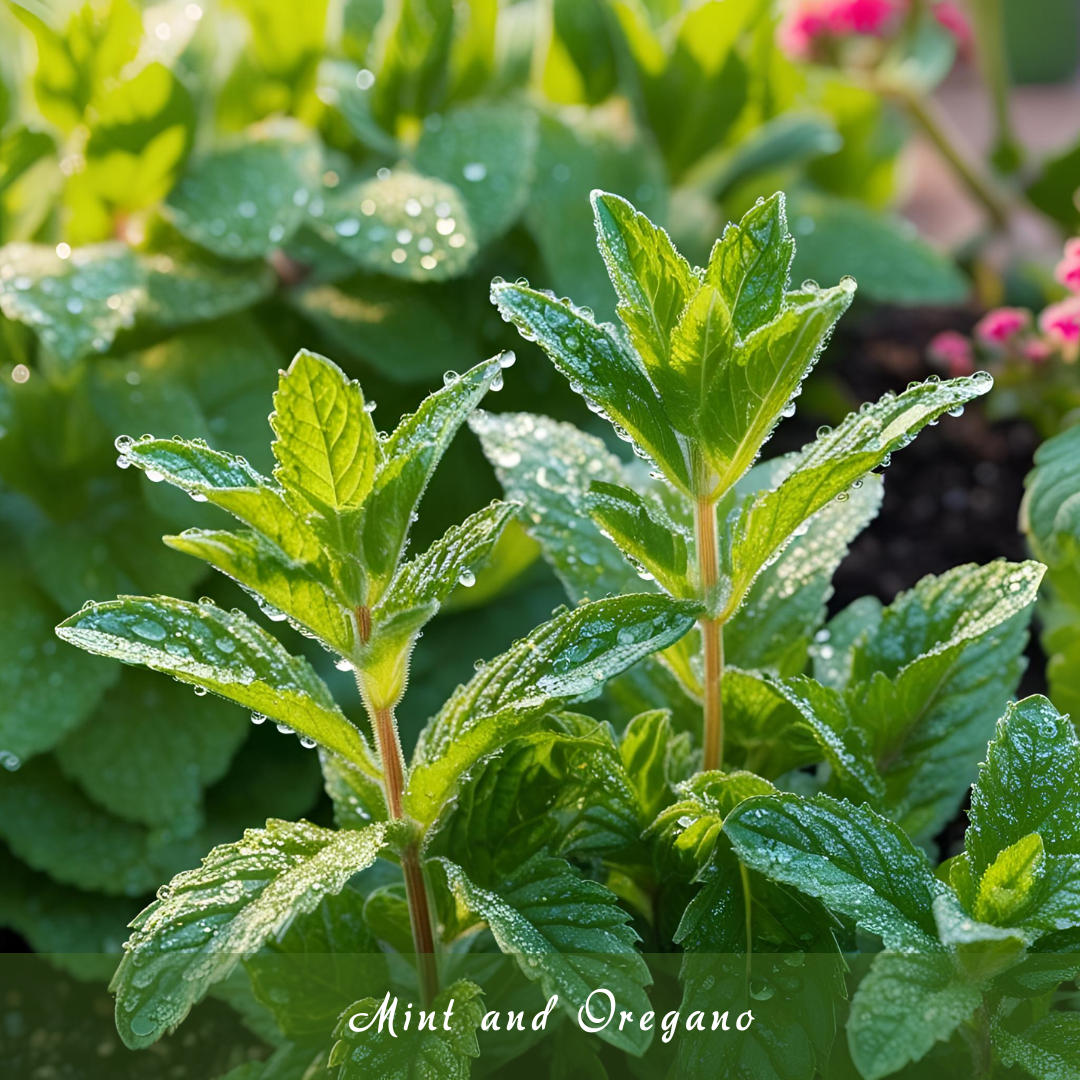
4. Parsley And Sage
Parsley and sage are great herbs to grow together in a kitchen herb garden. They complement each other’s growth and thrive together.
Why They Work Well Together
Pest Control
Sage's strong aroma repels pests such as cabbage moths, aphids, and beetles, protecting the surrounding plants. Meanwhile, parsley attracts beneficial insects, such as ladybugs and predatory wasps, which help control pest populations and promote healthy plant growth.
Growth Support
Sage’s woody structure provides vertical support, while parsley’s soft, leafy growth fills the gaps. Together, they create a well-balanced garden, maximizing space and supporting each other’s development, creating a harmonious and thriving herb garden.
Flavour Enhancement
Sage’s earthy, robust flavour pairs well with parsley’s fresh, bright taste, creating a balanced flavour profile in savory dishes. The combination is perfect in recipes like stuffing, roasts, and stews, adding complexity to each dish.
How To Grow Them Together
Plant sage and parsley in well-draining, fertile soil with good airflow. Both herbs prefer full sun but can tolerate light shade. Space parsley 8-10 inches away from sage to give them room to grow.
Both require moderate watering, keeping the soil moist but not waterlogged. Sage thrives in slightly drier conditions, so avoid overwatering. Ideal for USDA zones 4-8, these herbs thrive when grown together with minimal care and offer mutual support.
Turn Your Passion for Nature Into Income
🌿 Whether you love gardening, caring for animals, or exploring holistic living,
You can share your knowledge online and earn from it.
Discover how nature lovers are growing their passions into meaningful, income-generating blogs. 👇
5. Thyme And Rosemary
Thyme and rosemary are both Mediterranean herbs that love the same growing conditions. These two hardy plants make a perfect match for a herb garden.
Why They Work Well Together
Pest Control
Rosemary's strong scent repels insects like mosquitoes and cabbage moths, protecting nearby plants. Thyme also contributes by deterring pests and attracting beneficial pollinators, such as bees and hoverflies, promoting a healthier garden environment.
Growth Support
Rosemary's tall structure offers shade to the low-growing thyme, creating a natural canopy. This arrangement helps prevent thyme from scorching by excessive sun and provides visual interest in herb gardens.
Flavour Enhancement
Rosemary’s bold, pine-like flavour and thyme’s earthy, floral notes create a harmonious dish blend. Together, they elevate the taste of meats, roasted vegetables, and soups, complementing each other in various recipes.
How To Grow Them Together
Plant thyme and rosemary in well-drained soil with excellent airflow. Both herbs thrive in full sun and prefer dry to moderate watering.
Rosemary has deeper roots, so space them farther apart. They are drought-tolerant and grow well in poor, rocky soil. Avoid overwatering to prevent root rot. Suitable for USDA zones 6-9, both herbs require minimal care and flourish in a sunny, dry environment.
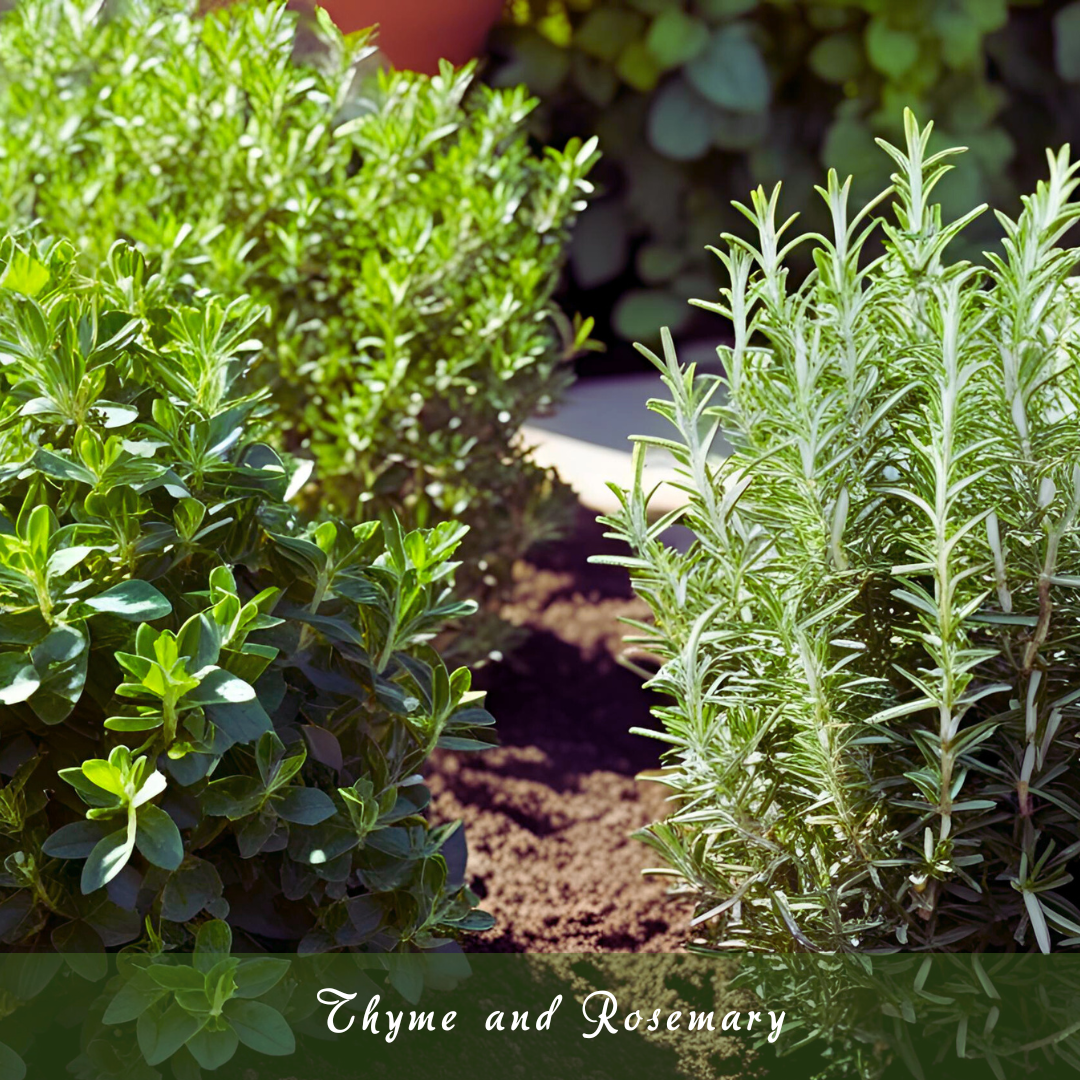
6. Lavender And Alliums (Garlic, Onions, Leeks)
Lavender and alliums are perfect herbs to grow together. They complement each other’s growth while enhancing the beauty and productivity of herb and vegetable gardens.
Why They Work Well Together
Pest Control
Lavender’s strong scent repels insects like mosquitoes, fleas, and moths, which can harm other plants. Like garlic and onions, alliums deter pests such as aphids, cabbage worms, and root maggots, making them an effective natural pest control duo.
Growth Support
Lavender grows tall and woody, creating a backdrop that supports the low-growing alliums. With their upright structure, alliums complement lavender by adding depth to the garden, creating a dynamic and aesthetically pleasing arrangement.
Flavour Enhancement
Lavender’s floral, sweet aroma contrasts beautifully with the alliums' savoury, pungent flavour. When paired, their unique tastes can elevate dishes from spicy sauces to roasted meats, providing a harmonious balance of flavours.
How To Grow Them Together
Plant lavender and alliums in well-drained, slightly alkaline soil with good airflow. Both thrive in full sun and require moderate watering, though lavender prefers drier conditions than alliums.
Space plants properly to ensure they have room to grow without overcrowding. Lavender’s tall growth provides a backdrop for the low-growing alliums. These herbs thrive in USDA zones 5-9, making them suitable for various garden settings.
7. Chamomile And Basil
Chamomile and basil are perfect herbs to grow together. They have various gardening benefits when planted side by side. When planted side by side
Why They Work Well Together
Pest Control
Chamomile attracts beneficial insects, such as ladybugs, which feed on aphids and other pests. Basil’s strong aroma repels mosquitoes, flies, and other garden pests, creating a natural pest barrier that benefits both the basil and the surrounding garden.
Growth Support
Chamomile's low, spreading growth acts as ground cover, helping retain moisture and suppress weeds around basil. In return, basil's taller growth offers shade to chamomile, protecting it from the harsh midday sun and preventing wilting.
Flavour Enhancement
Chamomile’s subtle, apple-like sweetness complements basil’s bold, peppery flavour. This pairing creates a harmonious balance, especially in dishes like herbal teas, fresh salads, and light, savoury meals, enhancing the taste experience.
How To Grow Them Together
When growing basil and chamomile together, ensure the soil is rich in nutrients, well-drained, and receives ample sunlight. Place chamomile 8 inches apart and basil 12 inches apart to provide adequate air circulation.
Both herbs prefer moderate watering but dislike waterlogging. Chamomile thrives in cooler temperatures, while basil prefers warm conditions, so ensure they are in a location that balances both needs. Suitable growing zones: USDA Zones 4-9.
8. Tarragon And Dill
Tarragon and dill are ideal herbs to grow together, as their aromatic flavours complement each other. They thrive together in the garden.
Why They Work Well Together
Pest Control
Dill attracts beneficial insects, such as ladybugs and hoverflies, which naturally control pests like aphids. Tarragon’s strong scent also acts as a natural repellent, deterring pests that could damage neighbouring plants.
Growth Support
Tarragon’s upright, bushy structure contrasts beautifully with dill’s feathery, soft leaves. This growth habit pairing creates an aesthetically pleasing herb garden while providing natural support for both plants.
Flavour Enhancement
Tarragon’s mild anise flavour pairs well with dill’s tangy, fresh taste. Together, they create a delightful balance that enhances seafood, chicken, and vegetable dishes, offering a unique combination of flavours in culinary creations.
How To Grow Them Together
Plant dill and tarragon in well-drained soil with full sun to partial shade. To give them space to grow, place them about 12 inches apart.
Dill prefers slightly cooler temperatures, while tarragon thrives in warmer conditions, making them compatible in many climates.
They grow well in USDA zones 4-9. Water consistently, but avoid over-watering. Frequent pruning promotes healthy growth and helps them keep their shape. Moderate watering is beneficial for both herbs.
FAQ
Q1. Can I Plant Different Herbs In The Same Container Or Garden Bed?
Yes! Many herbs thrive when grown together, especially if they share similar light, water, and soil preferences. Companion planting not only saves space but can also enhance growth and repel pests naturally.
Q2. Which Herbs Should Not Be Planted Together?
Mint spreads aggressively and can overwhelm other herbs. Although it shares growing needs with oregano, plant mint separately or contain its roots to avoid competition.
Q3. Do Companion Herbs Help Each Other Grow?
Yes! Certain herbs enhance the flavour, growth, or pest resistance of others. For example, basil can help repel aphids and improve the taste of nearby tomatoes or herbs.
Q4. How Should I Space Herbs In A Shared Container Or Bed?
Give each plant 6–12 inches of space, depending on the herb. This ensures good airflow and room for root growth. Use well-drained soil and don’t overcrowd.
Q5. Should I Fertilize Herbs Grown Together?
Light feeding is best. Use a diluted organic liquid fertilizer every 4–6 weeks during the growing season. Avoid over-fertilizing—too much can reduce flavour in culinary herbs.
Q6. Can I Harvest Herbs At Any Time?
Yes, but for the best flavour, harvest in the morning before the sun gets too hot. Regular harvesting also encourages new growth.
Conclusion
In conclusion, selecting the right herbs to grow together can create a more productive and sustainable garden, while enhancing the health of plants and the flavours of your culinary creations.
By pairing complementary herbs, you can create a thriving, low-maintenance garden that boosts productivity and reduces the need for chemical inputs.
With thoughtful planning, companion planting improves your garden's health and enhances your culinary experience, making it a win-win for both gardeners and chefs.
I trust you enjoyed this article on the Best Herbs To Grow Together For Flavour & Harmony. Please stay tuned for more inspiring guides, helpful tips, and ideas to help you live closer to nature every day.
Take care!
— JeannetteZ
💬 Your Opinion Is Important To Me
Do you have thoughts, ideas, or questions? I’d love to hear from you. Please leave your comments below or email me directly at Jeannette@Close-To-Nature.org.
📚 More Nature-Inspired Reads
Explore more ways to connect with nature, nurture your pets, and live in harmony with the world around you 🌿


